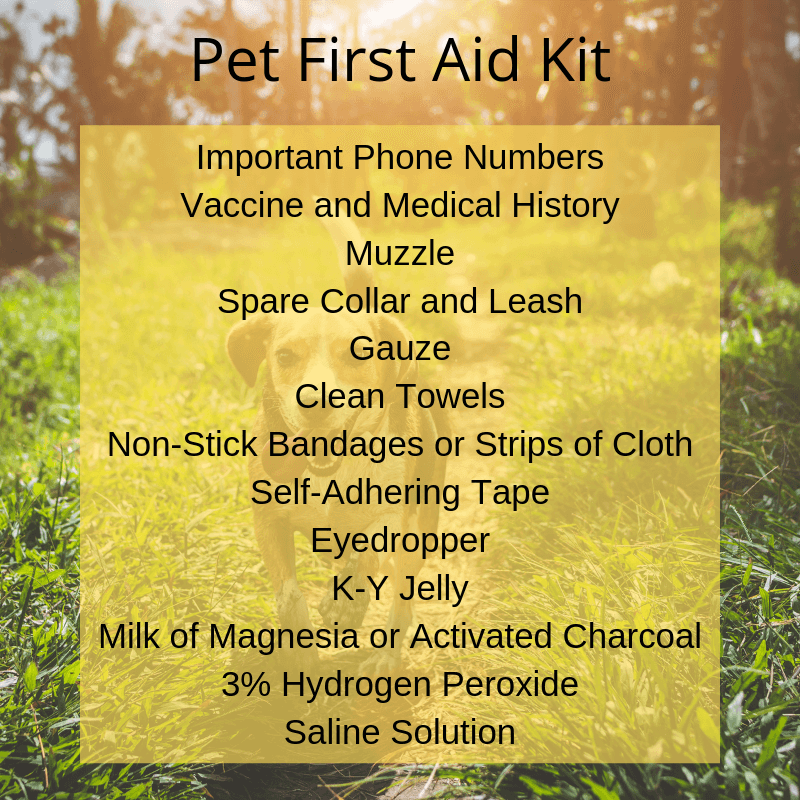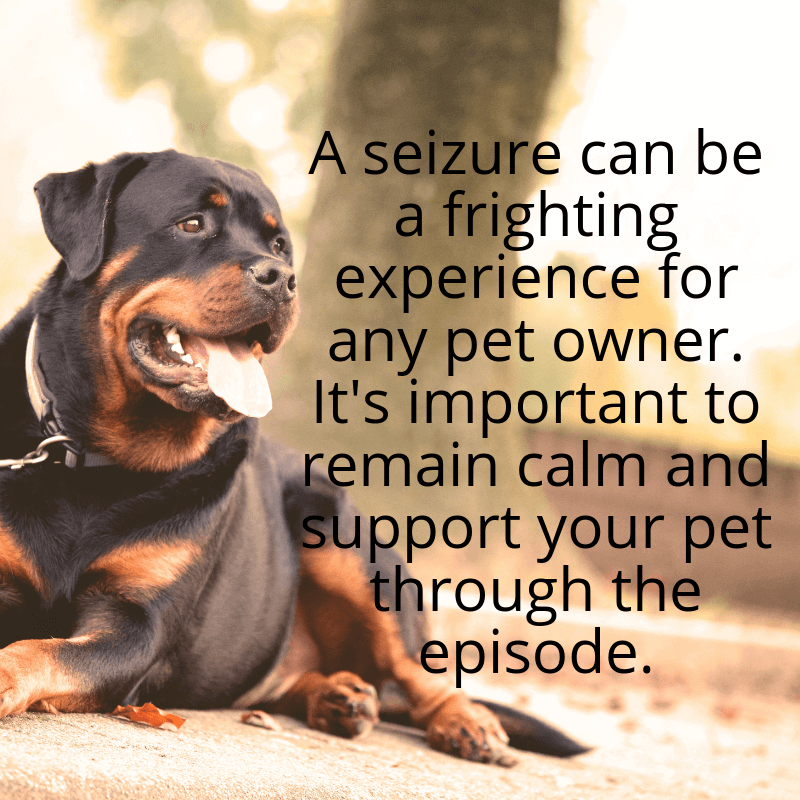Just like in human emergencies, knowing some life saving first aid could mean the difference between life and death for your pet.
Remember that any first aid administered to your pet should be followed by immediate veterinary care. First aid care is not a substitute for veterinary care, but it may save your pet’s life until he/she receives veterinary treatment. -American Veterinary Medical Association
It is always recommended you take a Pet First Aid or Pet CPR course by a certified instructor. The Red Cross offers a Pet First Aid online class for only $25 that we highly recommend.
Below we will outline some of the basic first aid situations you are able to assist with until you can get your pet into a veterinarian, but first, let's look at assembling a Pet First Aid Kit. Like with the rest of your family, it's a good idea to keep a first aid kit both in your car and at your home in case of emergencies. Having all the tools in one place is going to cut back on valuable time you'll need to help your pet.
Remember that pain, fear, and confusion can make pets react out of character for them. Never assume your pet, even if they are commonly calm and friendly, won't lash out in pain. Make sure you and other emergency personnel don't get bit. The use of a soft muzzle, while to you seems unnecessary, maybe a needed tool to help quickly and safety assist your pet. In most situations, calmly make your way to the nearest Emergency Veterinarian. Out of control, panicked driving only puts you and your pet in more danger.
 Assembling a Pet First Aid Kit:
Assembling a Pet First Aid Kit:
- Important phone numbers: Keep a list of important phone numbers such as your vet's office, the closest e-clinic, animal control, and poison control. You may also keep them as saved contacts in your phone for easy access.
- Pet Poison Control Center: 888-426-4435, they are open 24/7, 365 days a year.
- Vaccine and medical history: Keeping an up to date record of your pet's medical history is a huge help for a Veterinarian in case you are unable to bring them into your normal vet. With our new app PetPro Connect, you can keep your pet's up to date records with you at all times!
- Muzzle: When your pet is hurt they may react out of character and try to bite. A muzzle is a safety precaution for emergency vets, techs, and other personnel your pet may not know handling their emergency.
- Spare leash or collar: In the event you need to cut away your pet's collar or leash, make sure you have a backup.
- Gauze: Gauze can be used to both cover a wound but also as a soft muzzle for an injured pet.
- Clean towels: Towels can be used to help restrain an injured cat, for clean up or even padding.
- Non-stick bandages or strips of clean cloth: These can be used to wrap a wound and help control bleeding.
- Self-adhering, non-stick tape: Used to secure bandages.
- Eyedropper: You can use an eyedropper or a large syringe without the needle to help clean and flush wounds.
- K-Y Jelly: Can be used to help protect wounds and eyes.
- Milk of Magnesia or Activated Charcoal: Both can be used to help absorb poison (Should be used only if instructed to by your veterinarian or a poison control official).
- 3% Hydrogen Peroxide: to induce vomiting. (Should be used only if instructed to by your veterinarian or a poison control official, do not use Hydrogen Peroxide on open wounds).
- Saline solution: Saline can be used to clean wounds. Contact solution works well and may already be in your home.
Next, let's look at some common emergencies where you can intervene and assist while arranging transport to your veterinarian. Like humans, time is of the essence. If you believe your pet may be experiencing an emergency, contact us! We are more then willing to assist you and determine if you need to be seen right away or if there is another, less serious cause behind your pet's behavior.
What to do if Your Pet is Choking.
Like humans, pets who are choking may paw they their face excessively, have trouble breathing, make audible choking sounds, or excessively cough. They may also have blue-tinted lips or tongue.
If your pet can still breathe, keep them calm and take them to the nearest veterinarian.
If you can see what is blocking your pets airflow, you can try and reach in and grab it. However, you may inadvertently push the object farther down their windpipe. If you can see the object but are unable to reach it, quickly make your way to the nearest veterinarian.
If your pet has passed out and you are unable to remove the objects blocking your pet's airflow you should quickly make your way to the nearest veterinarian. On your way, you can also try performing the Heimlich Maneuver. Lay your pet on their side and place both hands on the side of your pet's ribcage. Apply quick and firm pressure 3 to 4 times to sharply push the air out of their lungs and force the object out of their windpipe. Repeat the process until the object has either come out or you arrive at your veterinarian. If your pet has passed out but you managed to remove the object causing the blockage, it is still advisable to bring your pet in and have them checked out by a veterinarian to make sure there is no other damage.
If you find your pet unconscious and see they aren't breathing, open their mouth and check their airway by grabbing their tongue and pulling it straight out of their mouth until it is flat. Check the throat for any obstructions.
What to do if Your Pet is Not Breathing and Has No Heartbeat
If there is nothing blocking your pet's airway, you can perform CPR. CPR in pets is more difficult than it is in humans because of their anatomy. If you simply breathe into their airway as you would with human CPR, you may inadvertently fill their stomach up with air instead of their lungs. If your pet struggles while trying to perform CPR they may not need it. You should head to the nearest veterinary facility and closely monitor your pet. Never perform CPR on a healthy pet. Like humans, giving CPR to a healthy individual may cause unnecessary damage.
Remember that your pet surviving resuscitation is very low. However, in an emergency situation, it is better to do something rather than nothing.
The American Veterinary Medical Association has outline how to perform basic CPR for your pet in an emergency situation.
- Stay calm.
- If possible, have another person call the veterinarian while you help your pet.
- Gently lay your pet on its right side on a firm surface. The heart is located on the left side in the lower half of the chest, just behind the elbow of the front left leg. Place one hand underneath the pet’s chest for support and the other hand over the heart.
- For dogs, press down with quick, firm pressure to depress the chest one inch for medium-sized dogs. Use more force for larger animals and less force for smaller animals.
- For cats and other small pets, cradle your hand around the animal’s chest so your thumb is on the left side of the chest and your fingers are on the right side of the chest, and compress the chest by squeezing it between your thumb and fingers.
- Press down 80-120 times per minute for larger animals and 100-150 times per minute for smaller ones (less than 25 lbs). "Stayin' Alive" by the Bee Gees has 100 BPM and is a good reference when doing chest compressions.
- Alternate the chest compressions with the rescue breaths: perform chest compressions for 4-5 seconds and stop long enough to give one rescue breath by opening your pet's mouth and pulling the tongue to the front of the mouth, closing their mouth and holding it while you tip their head up. Breathe into their nose enough to see their chest rise.
- Continue until you can hear a heartbeat and your pet is breathing regularly, or you have arrived at the veterinary clinic and they can take over the resuscitation attempts.
What to do if Your Pet is Poisoned
If you believe your pet may have been poisoned or gotten into any chemicals, contact your veterinarian, emergency veterinarian, or Animal Poison Control Center (888-426-4435, they are open 24/7, 365 days a year) as soon as possible. Be prepared with your pet's information such as breed, age, weight, and sex. They may ask you for symptoms and how many pets are involved. What your pet got into, how much were they exposed to, and how long ago it happened. Lastly, keep the packaging as a reference for your vet or poison control official.
Collect any and all throw-up or objects chewed for your veterinarian when you arrive for treatment.
Do not induce vomiting unless directed so by a veterinarian or poison control official. Depending on the substance, it may cause more harm coming back up. Many chemicals can cause burns to the throat when thrown back up.
 What to do if Your Pet is Having a Seizure
What to do if Your Pet is Having a Seizure
Seizures can be a frighting experience for any pet owner. It's important to remain calm and support your pet through the episode. Do not try and move or bring your pet in while they are actively seizing.
Move all furniture or other objects that may cause injury out of the way. Do not startle your pet or try and scare them out of the seizure. Comfort your pet. You may gently hold your pet but make sure you stay away from their face as they may unknowingly and uncontrollably bite down or snap while seizing. Do not try and hold their tongue. They will not choke on it and you will be putting your self in more danger by trying to reach into their mouths.
As far as we know, seizures are not painful and your pet is not aware of what is happening much like seizures in humans. A seizure is more traumatic for you as their family member than it is for them.
Time and, if you are able, record the seizure. The timing and video will help your veterinarian narrow down what the cause may be. Seizures are always a symptom of another medical issue with the most common cause being idiopathic epilepsy.
If the seizure lasts for more then 2-3 minutes, it can put your dog at risk for hyperthermia. Wet towels with cold water and put them around your pet's groin, neck, and paws. This will help cool them down.
If this is the first seizure your pet has ever had they need to been seen by a veterinarian as soon as possible. You may be asked to keep a journal of your pet's seizure activity after seeing your vet. Make sure to note the time, length, date, and severity of each seizure. The more information your veterinarian has, the more likely they are going to be able to give you a diagnosis and treatment.
If your pet has more than one seizure within 24 hours, this is known as a cluster seizure and needs to be seen as soon as possible.
What to do if Your Pet is Injured
If you are looking for an injury, do so slowly and stop if your pet becomes more agitated.
If possible try and splint your pet's injury before moving. Make sure the bandage isn't too tight. Keep in mind that in some cases a poorly applied bandage can do more harm than good. If in doubt, leave the bandaging to the professionals and head into your closest clinic as soon as possible.
If there is something sticking out from the wound, do not remove it. If possible cut it down to around 3 to 6 inches sticking out before transporting your pet.
Keep them confined while transporting. This will help prevent more injuries and lessen the chance of making their current one worse. Place smaller animals in a box or carrier. For larger dogs, a sled or a piece of wood can be used a makeshift stretcher. Give your veterinarian a heads up so that they know to expect you and can be ready to assist when you arrive.
What to do if Your Pet is Bleeding
If your pet is bleeding, more than likely it will stop itself. For larger wounds that won't stop, apply pressure with a clean cloth or towel for three minutes. After three minutes, check to see if the bleeding has stopped. For more serious bleeds that do not stop within three or so minutes or for larger gashes or wounds, get to your local veterinarian as quickly as possible. Add towel on top of towel once they bleed through and make sure not to remove them as it may disturb any clots that have formed.
What to do if Your Pet is Burned
Muzzle your pet and flush the burn with cool, not cold water. Head to your veterinarian immediately.
What to do if Your Pet Had Heatstroke
If you are unable to get your pet to your veterinarian right away move your pet into a shaded area and out of direct sunlight. Place cool or cold towels around your pet's neck and groin. Ring out towels and repeat as necessary.
You can also attempt to cool your pet down with a hose. Keep cool running water over your pet, especially their abdomen and between their back legs. Use your hands to remove the water once it has soaked up your pet's body heat.
Get your pet to your veterinarian as soon as possible. Even if the pet is no longer in distress, it is a good idea to check for any other damage.
What to do if Your Pet is Bitten by a Snake.
Always assume the snake is poisonous. Even if it is not, it is best to get the bite checked out by your vet for other damage. Try to identify the snake without putting yourself at risk. Do not bring the snake into your veterinarian. A photo or description will suffice.
Getting your pet to a veterinarian as quickly and safely as possible is the most important thing in case of an emergency.
While all our clinics are emergency prepared, our Russell Ridge location is open 7 days a week, from 7:30 to 6. We take all kinds of emergencies and are willing to help in any way necessary.
For more emergencies and list of local Emergency Veterinarians head on over to our Emergency Page
